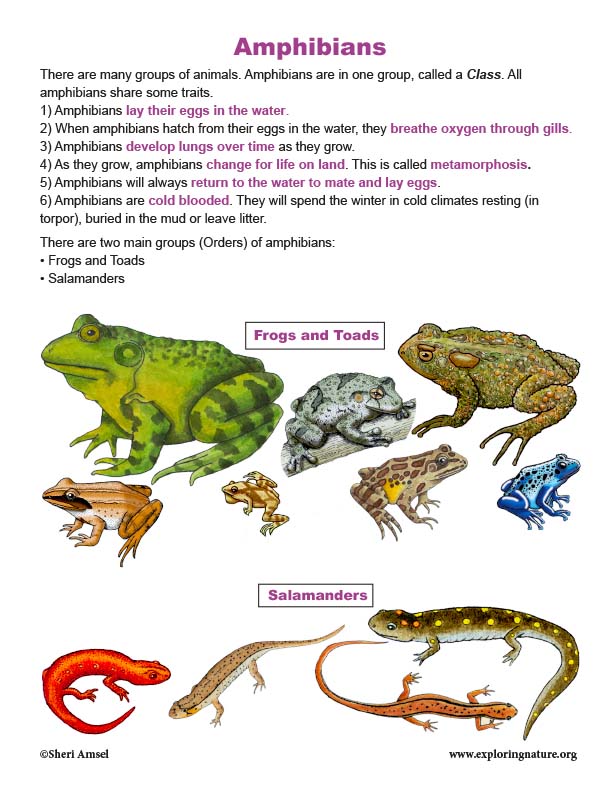

Have students read about Amphibians. Then have them take the Short Answer Quiz and the Amphibians Matching Traits Quiz to assess their comprehension.
There are many groups of animals. Amphibians are in one group, called a Class. All amphibians share some traits.
Amphibians live in or near water; ponds, lakes, rivers, streams or wetlands.
They lay their eggs in the water.
When amphibians first hatch from their eggs in the water, they breathe through gills.
As they grow, their lungs form and by the time they are adults, they breathe through lungs, instead of gills.
Amphibians’ bodies change as they grow as well. Frogs hatch out as tadpoles, but over time grow front and back legs and lose their long tail. They are changing to get ready for their adult lives on land. This change is called metamorphosis.
Though adult amphibians may spend time on land, they always come back to the water to mate and lay eggs.
Amphibians are cold blooded. They are not active in cold weather. Amphibians that live in northern regions, spend the winter months sleeping (in torpor), buried in the mud or under the leaf litter.
Amphibians are broken down into smaller groups (Orders). One group includes frogs and toads and another group includes salamanders. You can see from looking at them that the toads and frogs look different from the salamanders. Salamanders have long tails, toads and frogs do not. Salamanders have front and back legs that are about the same size. Frogs and toads have much bigger back legs than front legs. This trait is what allows them to jump.
NGSS Disciplinary Core Ideas
LS4.D: Biodiversity and Humans
• There are many different kinds of living things in any area, and they exist in different places on land and in water. (2-LS4-1)
Performance Expectations
Students who demonstrate understanding can:
2-LS4-1. Make observations of plants and animals to compare the diversity of life in different habitats. [Clarification Statement: Emphasis is on the diversity of living things in each of a variety of different habitats.] [Assessment Boundary: Assessment does not include specific animal and plant names in specific habitats.]
Disciplinary Core Ideas
LS1.B: Growth and Development of Organisms
• Reproduction is essential to the continued existence of every kind of organism. Plants and animals have unique and diverse life cycles. (3-LS1-1)
Performance Expectations
Students who demonstrate understanding can:
3-LS1-1. Develop models to describe that organisms have unique and diverse life cycles but all have in common birth, growth, reproduction, and death.
Disciplinary Core Ideas
LS1.A: Structure and Function
• Plants and animals have both internal and external structures that serve various functions in growth, survival, behavior, and reproduction. (4-LS1-1
LS1.D: Information Processing
• Different sense receptors are specialized for particular kinds of information, which may be then processed by the animal’s brain. Animals are able to use their perceptions and memories to guide their actions. (4-LS1-2)
Performance Expectations
Students who demonstrate understanding can:
4-LS1-1. Construct an argument that plants and animals have internal and external structures that function to support survival, growth, behavior, and reproduction. [Clarification Statement: Examples of structures could include thorns, stems, roots, colored petals, heart, stomach, lung, brain, and skin.] [Assessment Boundary: Assessment is limited to macroscopic structures within plant and animal systems.]
4-LS1-2. Use a model to describe that animals receive different types of information through their senses, process the information in their brain, and respond to the information in different ways. [Clarification Statement: Emphasis is on systems of information transfer.] [Assessment Boundary: Assessment does not include the mechanisms by which the brain stores and recalls information or the mechanisms of how sensory receptors function.]


